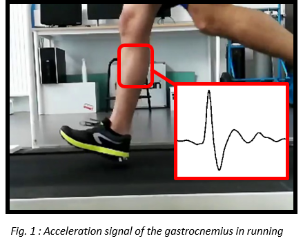INTERACTION BETWEEN SOFT TISSUE VIBRATIONS AND MORPHOLOGICAL/FUNCTIONAL CHARACTERISTICS OF THE RUNNER: IMPLICATIONS ON FOOTWEAR AND FATIGUE
Trainee: Marie-Caroline Play (PhD Student)
Collaborators:Dr Jérémy Rossi (LIBM Saint-Etienne) & Dr Marlène Giandolini (Amer Sports Footwear Innovation and Sport Sciences Lab, Salomon SAS, Annecy, France)
SCIENTIFIC SUMMARY

In running, each foot contact causes an impact considered as an input into the musculoskeletal system. This involves a sudden deceleration of soft tissue packages including muscles, because of the shock wave generated beneath the foot travelling along the full body up to the head. As the frequency of impact forces in running are close to the natural frequency of soft tissue packages, soft-tissue vibrations may occur because of a resonance phenomenon (Fig. 1).

Runners’ biomechanical and muscular adaptations (i.e. muscle tuning) may help minimizing stress and discomfort. Additionally, footwear, especially midsole materials, has the potential to influence soft tissue vibrations. However, these changes are highly subject-specific, which leads to differences in functional groups.
This PhD project aims at identifying these runner’s profiles based on vibrational (Fig. 2) and anthropometric variables, in order to design a shoe minimizing soft tissue vibrations and potentially neuromuscular fatigue.
Key words: Running, Soft-Tissue Vibrations, Footwear, Damping, Muscular Activity, Neuromuscular Fatigue, Functional groups.
